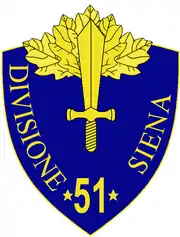51st Infantry Division Siena
The 51st Infantry Division Siena (Italian: 51a Divisione di Fanteria "Siena") was a regular infantry division of the Italian Army during World War II. The Siena Division was formed 15 September 1939 and dissolved 8 September 1943. Historically a Campanian unit, it was made almost entirely of Neapolitans.
| 51st Infantry Division Siena | |
|---|---|
 51st Infantry Division Siena Insignia | |
| Active | 1939–1943 |
| Country | |
| Allegiance | King of Italy |
| Branch | |
| Type | Infantry |
| Size | Division |
| Garrison/HQ | Naples |
| Nickname(s) | Siena |
| Engagements | World War II |
| Commanders | |
| Notable commanders | General Ercole Caligian, General Gualtiero Gabutti,[1] General Giulio Perugi, Lieutenant General Angelico Carta |
Actions
By 10 June 1940, Siena was transferred to Piedmont as part of the army reserve, and did not participate in Italian invasion of France. Fully mobilized in August 1940, the Siena division received orders to move to Albania in September 1940.[2] By the start of Greco-Italian War On 28 October 1940, the division was deployed in the Delvinë-Konispol region as part of the Italian VIII Corps, covering the border from Mal Stugarë where it was adjacent to the 23rd Infantry Division Ferrara to the coast. Ordered to participate in the attack on the Greek city of Ioannina, the division failed to cross the Thyamis river until 6 November 1940 due to heavy Greek resistance. On 6 November 1940, the beachhead across the Thyamis was established, but the division immediately turned to a defensive stance because of the rapid pace of Greek forces build-up. On 14 December 1940, it repelled Greek probing attacks, but by 19 December was retreating with the main forces from the line from Himarë to Kallarat. It was able to stop the Greek advance just short of the valley of Shushicë, on the mountaintops of Mali i Çorajt to Horë-Vranisht. The fighting was bloody, with the infantry regiments of Siena down to the battalion strength.[3] The 33rd Mountain Infantry Division Acqui came to the rescue on 24 December 1940, and by 26 December 1940 the Siena division was relieved from front line duties and sent to Berat to regroup.
To plug the Greek breakthrough after the Capture of Klisura Pass, on 25 January 1941 the Siena division was assigned to the line from Qafa e Kiçokut – Monastery Hill (Height 731) north of Këlcyrë. It managed to stop the breakthrough, despite incessant Greek attacks. On 8 February 1941, the division was sent to reserve again. It participated in the Italian Spring Offensive on 19 March 1941 (with disastrous results) and in the Battle of Greece, capturing Këlcyrë on 14 April 1941. An order was given to Siena on 16 April 1941 to stop and to give way to the 47th Infantry Division Bari.
After the fighting ended, Siena was first re-organized in the Osum valley and then sent to Peloponnese at the beginning of May 1941, forming garrisons in Corinth, Nemea, Argos and Nafplion. In late September 1941, the division was transferred to the eastern part of the island of Crete, joining the Italian XXVI Corps. On 18 April 1943, parts of Siena repelled an Allied landing attempt on the island of Koufonisia. The division remained in Crete until September 1943, when Italy surrendered to the Allies according to the Armistice of Cassibile and the division was disarmed by the Germans.[4] In October 1943, about 2,000 men were killed when they were transported to the mainland as PoWs on the MS Sinfra, which was sunk by US and British planes. Another 2,670 men drowned in February 1944 on the SS Petrella, which was torpedoed by the British submarine HMS Sportsman.
Orders of battle

Order of battle (1940)
- 31. Siena Infantry Regiment
- 32. Siena Infantry Regiment
- 265. Lecce Infantry Regiment
- 341. Infantry Regiment (from 37th Mountain Infantry Division Modena)
- 51. Artillery Regiment
- 1. Artillery group
- 2. Artillery group
- 3. Artillery group
- 141. CCNN Legion
- 141. CCNN Battalion "Capuana"
- 251. Machine gun company
- 51. Mortar Battalion (da 81)
- 312. Tank Battalion (transferred to command of 50th Infantry Division Regina later)
- 51a Anti-Tank Company (47/32)
- 251. Anti-Tank Company (47/32)
- 51. Mixed telegraph/radio Signal Company
- 160. Mixed telegraph/radio Signal Company
- 83. Pioneer Company [nb 1][4]
Order of battle (1943)
- 31. Siena Infantry Regiment
- 32. Siena Infantry Regiment
- 51. Artillery Regiment
- 1. Artillery group
- 2. Artillery group
- 3. Artillery group
- 141. CCNN Legion
- 141. CCNN Battalion "Capuana"
- 251. Machine gun company
- 51. Machine gun battalion
- 51. Mortar Battalion (da 81)
- 312. Tank Battalion (1 company, the rest is under 50th Infantry Division Regina)
- 51. Pioneer battalion
- 51. Chemical warfare platoon
- 1. District detachment of Guardia di Finanza
Notes
- Footnotes
- An Italian Infantry Division normally consisted of two Infantry Regiments (three Battalions each), an Artillery Regiment, a Mortar Battalion (two companies), an Anti Tank Company, a Blackshirt Legion of two Battalions was sometimes attached. Each Division had only about 7,000 men, The Infantry and Artillery Regiments contained 1,650 men, the Blackshirt Legion 1,200, each company 150 men.[5]
- Citations
- Enrico Tagliazucchi and Franco Agostini. "Royal Italian Army". World War II Armed Forces – Orders of Battle and Organizations. Archived from the original on 4 April 2009. Retrieved 4 May 2009.
- http://www.regioesercito.it/reparti/fanteria/rediv51.htm
- http://www.regioesercito.it/reparti/fanteria/rgt/rgt31.htm
- Marcus Wendal. "Italian Army". Axis History. Retrieved 4 May 2009.
- Paoletti, p 170
- Paoletti, Ciro (2008). A Military History of Italy. Greenwood Publishing Group. ISBN 0-275-98505-9.